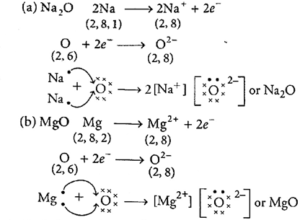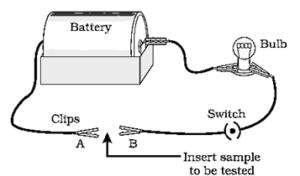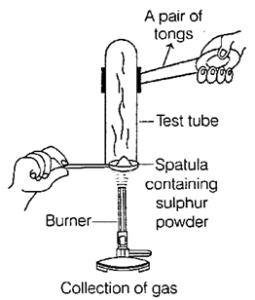Metals and Non-Metals
Class-10-CBSE-NCERT-Science-Chapter-3
Solutions : Intext and Exercises Solution
In−text Solutions (Page 40)
Question 1. Give an example of a metal which
(i) is a liquid at room temperature.
(ii) can be easily cut with a knife.
(iii) is the best conductor of heat.
(iv) is a poor conductor of heat.
(i) Metal that exists in liquid state at room temperature → Mercury (ii) Metal that can be easily cut with a knife → Sodium (iii) Metal that is the best conductor of heat → Silver (iv) Metals that are poor conductors of heat → Mercury and lead
Question 2. Explain the meanings of malleable and ductile.
Malleable: Substances that can be beaten into thin sheets are called malleable. Examples : Metals like Ag (silver), Au (gold) etc. Ductile: Substances that can be drawn into thin wires are called ductile. Examples : Ag (silver), Au (gold) etc.
In−text Solutions (Page 46)
Question 1. Define the following terms.
(i) Mineral (ii) Ore (iii) Gangue
Question 2. Write equations for the reactions of
(i) iron with steam
(ii) calcium and potassium with water

Question 3. Samples of four metals A, B, C and D were taken and added to the following solution one by one. The results obtained have been tabulated as follows.
| Metal | Iron(II) sulphate | Copper(II) sulphate | Zinc sulphate | Silver nitrate |
| A | No reaction | Displacement | ||
| B | Displacement | No reaction | ||
| C | No reaction | No reaction | No reaction | Displacement |
| D | No reaction | No reaction | No reaction | No reaction |
Use the Table above to answer the following questions about metals A, B, C and D.
(i) Which is the most reactive metal?
(ii) What would you observe if B is added to a solution of Copper(II) sulphate?
(iii) Arrange the metals A, B, C and D in the order of decreasing reactivity.
(i) As per reactivity series, Iron is most reactive metal among Iron, Silver and Copper. Since B can displace Iron from its sulphate, so B is the most reactive metal (ii) B will displace Cu from CuSO4 solution because B is more reactive than copper. (iii) The order of reactivity is B > A > C > D.
Question 4. Which gas is produced when dilute hydrochloric acid is added to a reactive metal? Write the chemical reaction when iron reacts with dilute H2SO4.
Hydrogen gas is produced when dilute hydrochloric acid is added to a reactive metal. The chemical reaction when iron reacts with dil. H2SO4 is as follows

Question 5. What would you observe when zinc is added to a solution of iron(II) sulphate? Write the chemical reaction that takes place.
Zinc being more reactive than iron displaces iron from iron (II) sulphate solution. As the result, the green colour of the solution fades and iron metal gets deposited. The chemical reaction when iron reacts with dil. H2SO4 is as follows.

In−text Solutions (Page 49)
Question 1.
(i) Write the electron−dot structures for sodium, oxygen and magnesium.
(ii) Show the formation of Na2O and MgO by the transfer of electrons.
(iii) What are the ions present in these compounds?
(i) The electron dot structures of sodium (Na), oxygen (O) and magnesium (Mg) are tabulated below. (ii) Ionic bond is formed in Na2O and MgO. (iii) (a) Na2O has Na+ and O2− ions. (b) MgO has Mg2+ and O2− ions.
Element
Atomic number
Electronic configuration
Electron dot structure
Na
11
2,8,1
O
8
2,6
Mg
12
2,8,2
:Mg

Question 2. Why do ionic compounds have high melting points?
In−text Solutions (Page 53)
Question 1. Define the following terms.
(i) Mineral (ii) Ore (iii) Gangue
(i) Mineral : The naturally occurring elements or compounds of metals present in the earth's crust are called minerals. (ii) Ore : Ores are those minerals from which a particular metal can be extracted profitably by using certain process. (iii) Gangue : The undesirable impurities present in the ore are called gangue or matrix.
Question 2. Name two metals which are found in nature in the free state.
The metals at the bottom of the reactivity series are mostly found in free state. Examples: gold, silver, and platinum.
Question 3. What chemical process is used for obtaining a metal from its oxide?
Metal is obtained from its oxide by reduction. The reduction can be done either by heating with carbon (coke) or by using highly reactive metals such as sodium, calcium, aluminium etc. e.g. ZnO(s) + C(s) → Zn(s) + CO(g) Zinc oxide Coke Zinc Carbon monoxide This reaction is highly exothermic. The heat produced is so large that metal is produced in the molten state.
In−text Solutions (Page 55)
Question 1. Metallic oxides of zinc, magnesium and copper were heated with the following metals.
| Metal | Zinc | Magnesium | Copper |
| Zinc oxide | |||
| Magnesium oxide | |||
| Copper oxide |
In which cases will you find displacement reactions taking place?
Metal
Zinc
Magnesium
Copper
Zinc oxide
No Reaction
Displacement
No Reaction
Magnesium oxide
No Reaction
No Reaction
No Reaction
Copper oxide
Displacement
Displacement
No Reaction
Question 2. Which metals do not corrode easily?
Metals present at the bottom of the reactivity series do not corrode easily, e.g. gold, silver, platinum etc.
Question 3. What are alloys?
Exercise Solutions
Question 1. Which of the following pairs will give displacement reactions?
(a) NaCl solution and copper metal
(b) MgCl2 solution and aluminium metal
(c) FeSO4 solution and silver metal
(d) AgNO3 solution and copper metal.
(d) AgNO3 solution will give displacement reaction with copper (Cu) because copper is placed above silver in the activity series, i.e. copper is more reactive than silver. 2AgNO3(aq) + Cu(s) → Cu(NO3)2(aq) + 2Ag(s)
Question 2. Which of the following methods is suitable for preventing an iron frying pan from rusting?
(a) Applying grease
(b) Applying paint
(c) Applying a coating of zinc
(d) All of the above.
(c) Applying a coating of zinc will prevent an iron frying pan from rusting.
Question 3. An element reacts with oxygen to give a compound with a high melting point. This compound is also soluble in water. The element is likely to be
(a) calcium
(b) carbon
(c) silicon
(d) iron.
(a) Calcium : The compound is likely to be calcium (Ca) because it combines with oxygen to give CaO (calcium oxide) with very high melting point. Calcium oxide dissolves in water to form calcium hydroxide. 2Ca(s) + O2(g) → 2CaO(s) CaO(s) + H2O(l) → Ca(OH)2(aq)
Question 4. Food cans are coated with tin and not with zinc because
(a) zinc is costlier than tin.
(b) zinc has a higher melting point than tin.
(c) zinc is more reactive than tin.
(d) zinc is less reactive than tin.
(c) zinc is more reactive than tin : Food cans are not coated with zinc because being more reactive than tin, zinc can react with organic acids present in the food.
Question 5. You are given a hammer, a battery, a bulb, wires and a switch.
(a) How could you use them to distinguish between samples of metals and
non-metals?
(b) Assess the usefulness of these tests in distinguishing between metals and non-metals.
(a) There are some ways by which we can distinguish between metals and non-metals as follows. (b) From the above tests, it is clear that metals are generally malleable, sonorous and good conductors of electricity, while non-metals are generally non-malleable/brittle, non-sonorous and poor conductors of electricity.

Question 6. What are amphoteric oxides? Give two examples of amphoteric oxides.
The metallic oxides which show the properties of acids as well as bases are called amphoteric oxides. It means that they react with both bases and acids to form salt and water. e.g. ZnO and Al2O3.

Question 7. Name two metals which will displace hydrogen from dilute acids, and two metals which will not.
Zinc and magnesium displace H2 from dilute acids while copper and silver do not.
Question 8. In the electrolytic refining of a metal M, what would you take as the anode, the cathode and the electrolyte?
Question 9. Pratyush took sulphur powder on a spatula and heated it. He collected the gas evolved by inverting a test tube over it, as shown in figure below.
(a) What will be the action of gas on
(i) dry litmus paper?
(ii) moist litmus paper?
(b) Write a balanced chemical equation for the reaction taking place.

(a) (b) S(s) + O2(g) → SO2(g) SO2(g) + H2O(l) → H2SO3(aq)
Question 10. State two ways to prevent the rusting of iron.
Here are some ways to keep iron from rusting:
(i) Painting or greasing the surface of iron can keep it from rusting by preventing direct contact with air.
(ii) The iron surface is galvanized, which coats it with zinc. Zinc is more reactive than iron, hence it will rust instead of iron.
Question 11. What type of oxides are formed when non-metals combine with oxygen?
Non-metals form acidic oxides, i.e. their aqueous solution turns blue litmus solution red.

Question 12. Give reasons
(a) Platinum, gold and silver are used to make jewellery.
(b) Sodium, potassium and lithium are stored under oil.
(c) Aluminium is a highly reactive metal, yet it is used to make utensils for cooking.
(d) Carbonate and sulphide ores are usually converted into oxides during the process of extraction.
(a) Platinum, gold and silver are non-reactive and give shining surface. (b) Sodium, potassium and lithium are very reactive and catch fire when exposed to air. (c) Aluminium forms a non-reactive layer of aluminium oxide on its surface. (d) It is easier to reduce oxides into metal.
Question 13. You must have seen tarnished copper vessels being cleaned with lemon or tamarind juice. Explain why these sour substances are effective in cleaning the vessels.
Question 14. Differentiate between metal and non-metal on the basis of their chemical properties.
which are electrovalent.
Metal
Non-metal
Metals form basic oxides, some of which form alkalis.
Non-metals form acidic or neutral oxides.
Metals replace hydrogen from acids and form salts.
Non-metals do not replace hydrogen from acids.
With chlorine, metals form chlorides which are electrovalent.
With chlorine non-metals form chlorides which are covalent.
With hydrogen few metals form hydrides
With hydrogen non-metals form many stable hydrides which are covalent.
Question 15. A man went door to door posing as a goldsmith. He promised to bring back the glitter of old and dull gold ornaments. An unsuspecting lady gave a set of gold bangles to him which he dipped in a particular solution. The bangles sparkled like new but their weight was reduced drastically. The lady was upset but after a futile argument the man beat a hasty retreat. Can you play the detective to find out the nature of the solution he had used?
The man used aqua-regia, a mixture of conc. HCl and conc. HNO3 in the ratio of 3 : 1. This is the only solution, that can dissolve gold. As the gold from the bangles was dissolved in aqua-regia, their weight was reduced drastically.
Question 16. Give reasons why copper is used to make hot water tanks and not steel (an alloy of iron).
Iron (or steel) is more reactive than copper. Iron in contact with steam form Fe3O4. 3Fe(s) + 4H2O(g) → Fe3O4(s) + 4H2(g) So, the body of tank is made of copper but not steel as copper does not react with water.
Click on below links to get PDF from store
PDF : Class 10th-Science-Chapter-3-Metals and Non-Metals-Text Book
PDF : Class 10th-Science-Chapter-3-Metals and Non-Metals-Notes
PDF : Class 10th-Science-Chapter-3-Metals and Non-Metals-Solution
Main Page : NCERT-Class-10-Science – All chapters notes, solutions, videos, test, pdf.
Previous Chapter : Chapter-2- Acids, Bases and Salts – Online Solution
Next Chapter : Chapter-4- Carbon and its Compounds – Online Solution
We reply to valid query.